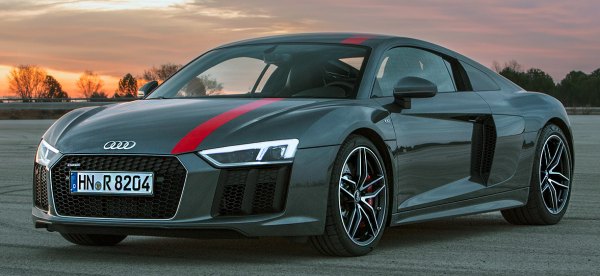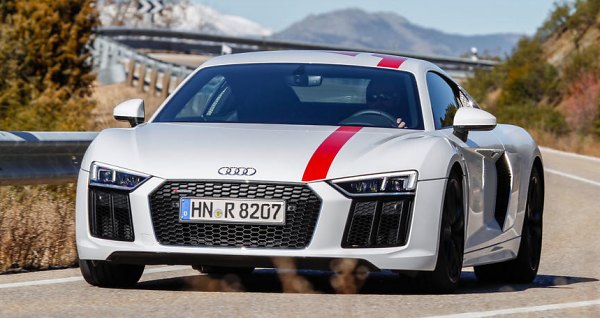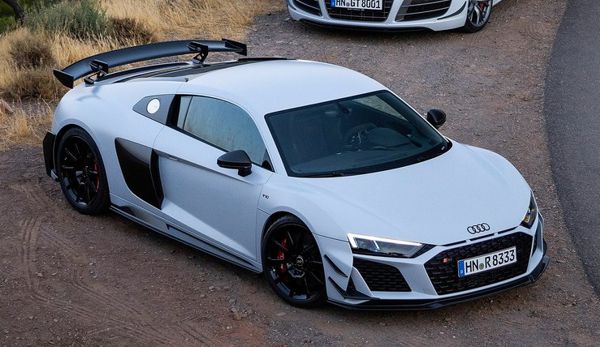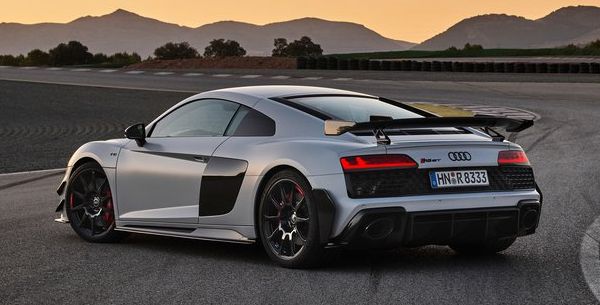| Published
on 21
Sep
2015 |
All rights reserved.
|
|
|
The original Audi R8
was one of the very few in our memory managed to
beat Porsche 911 – the last time was probably Honda NSX in 1990. It was
head-turning beautiful and made with impeccable quality. It had
some of the best engines in the industry, no matter the base 4.2 V8 or
flagship 5.2 V10.
It accelerated, steered and braked exactly as a junior supercar should
– and
that was a huge surprise for something wearing the 4-ring badge –
yet it was comfortable and practical for everyday use. Like NSX, its
place in automotive history is guaranteed. In fact, the bar it set
was so high that I’m afraid the new generation R8 could struggle to
match.
By numbers, the new R8 is unquestionably superior to the old car. Given
8 more years of progress, it gets more powerful, it goes faster,
corners swifter and uses fuel more efficiently. Every objective measure
points to the positive direction. However, is it more attractive to our
eyes? I'm afraid not.
In pictures, the new R8 looks even a little bit odd. It seems like the
designer could not improve over the old car but he needed something
different, so he abandoned the elegant details and replaced them with
exaggerative ones. One of them is the pair of trapezoidal headlamps.
Their angular shapes look at odds in relation to the smooth body
profile. Ditto the square intakes underneath them and the hexagonal
front grille. Other nice features
could not escape from the axe, too. The best visual element of the
original R8 was its black side blades which bridged the quarter windows
and side intakes. The new car has them replaced with ordinary-looking
separate elements. Why does it change for the sake of change?
However, the most disgusting to me is not the design details but the
side profile. Gone is the old car’s subtly sexy, gently curving
waistline. Enters a
straight line which looks as if drawn by a lazy draftsman using a
ruler. Curves also lose
place at the tail, which becomes flat and rectangular. The resultant
shape becomes closer to a Bugatti Veyron, or simply a big cockroach!
Well, some say the new car looks better in person under natural
sunlight. Maybe they are right, but the fact that it can’t match the
aesthetic of the original R8 is not an amusing starting point,
especially
when the high-end sports car segment is crowded with many great rivals
these days.
The cockpit is typical Audi: high-quality, ergonomically sounded
and
packed with technologies. The main instrument now becomes a
large, 12.3-inch TFT screen which is shared with the smaller TT. It can
display Google map and satellite navigation info at the background of
the dials, so you don’t need to switch your sight between instrument
pod and center console. Space is abundant in the cabin, with extra
space behind the seats for a couple of soft bags or briefcases.
Visibility all-round is good for a mid-engined sports car. On the
downside, the
interior design looks somewhat ordinary for a car of this class. It
lacks the theatrical effect of Lamborghini Huracan or AMG GT. The
materials, while high-quality for an Audi, are not as special as
McLaren or Ferrari. For example, the shift paddles are aluminum-look
plastics
instead of real aluminum, and we can’t see any signs of carbon-fiber.
Carbon-fiber does exist in the chassis though. Like sister car
Lamborghini Huracan with which it shares platform (if not exactly the
same chassis as the Audi’s wheelbase is 30 mm longer), the aluminum
spaceframe chassis is now reinforced by a carbon-fiber transmission
tunnel and rear bulkhead. This hybrid structure lifts torsional
rigidity by 40 percent and cuts weight by 15 percent compared with the
last generation. Size-wise, the new body changes little – merely 20 mm
shorter, 10 mm wider and 10 mm lower – but the whole car is now 40 to
50 kilograms lighter.
As before, the R8 rides on classic double-wishbone suspensions at all
corners and magnetorheological adaptive dampers are optional. Like
Lambo Huracan again, it abandons hydraulic power steering for a
variable-ratio electrical rack, and the old-fashioned viscous-coupling
4WD hardware is replaced with modern computer-controlled one using
Haldex multi-plate clutch to engage the front axle. This quickens
response and allows more torque to be transferred to the front wheels
when required. The rear axle is served with a mechanical LSD only. I
think an active differential would have been more effective to tame the
4WD’s understeer.
The last R8 was originally designed to rival 911 Carrera S, so
initially it was powered by a high-revving 4.2-liter V8. We loved that
motor very much, but the market seemed to prefer more power as the
all-aluminum Audi commanded higher prices than its rival. Therefore,
the Lamborghini V10 (actually built by Audi) was introduced a couple of
years later and it gradually took over the majority of sales – BTW, the
dream of repeating the sales success of 911 never materialized. Perhaps
this is why the new R8 is launched with only V10 engines. Inevitably,
its market position is lifted to the league of 911 Turbo or Aston
Martin V12 Vantage, as you can see in the AutoZine Rating page.
The new 5.2-liter V10 is a development from the old one, or basically
the same unit as Huracan. It is equipped with dual-mode (direct and
port) injection, variable intake, automatic stop-start and cylinder
deactivation, which shuts down 5 cylinders under light load. There are
2 states of tune: the standard R8 V10 offers 540 horsepower and 398
pound-foot of torque, marginally more than the old car, whereas R8 V10
Plus pumps up the figures to 610 hp and 413 lbft, or exactly the same
as its Lamborghini cousin. Audi quotes 205 mph and 0-60 mph in 3.1
seconds for the Plus model, so it is virtually as fast as the Huracan,
Ferrari 488GTB or McLaren 650S. The 7-speed S tronic twin-clutch
gearbox is carried over from the old car.
Apart from engine, the V10 Plus differs from the lesser model by using
larger wheels, wider rear tires, standard ceramic brakes and a fixed
carbon-fiber rear spoiler (instead of pop-up one). Its suspension
tuning is sportier, and the 7-speed S tronic has close ratios instead
of the lesser model's 6-speed plus an overdrive. In UK, the V10 and V10
Plus cost
£120,000 and
£135,000 respectively. Obviously, they target
at 911 Turbo and Turbo S respectively. There might be an entry-level
model to be added in a couple of years. If it really happens, I suppose
the most likely powerplant will be a twin-turbo 3.0 V6, which has been
introduced to S4 last week and will be upgraded to serve RS4. Expect
something in the region of 450 hp. Sorry, the good old naturally
aspirated V8 is
dead.
On the Road
Fortunately, the V10 remains naturally aspirated. And what a gem it is!
In terms of outright punch it might lose a little to the turbocharged
McLaren or Ferrari, but its throttle response is instantaneous, without
troubled by the slightest lag. Its power delivery is creamy linear and
it loves to rev. Peak power does not arrive until 8250 rpm, and it
keeps revving eagerly towards the 8500 rpm redline. The thunderous howl
it produces at such revs is addictive, although the sound insulation
doesn’t let as much to propagate into the cabin compared with its
Lamborghini cousin. Meanwhile, the gearbox works seamlessly together
with the high-revving motor. Its gearshifts are markedly improved,
being fast yet smooth, without the slight brutality of Huracan. The
powertrain combo has to be the best element of the new R8. It makes you
feel more engaged and more in control than its turbocharged rivals.
Yes, it won’t be as quick on a race track, but who cares?
As before, the R8 is a good companion for everyday driving. It rides
pretty good, even without the optional adaptive dampers. With them
equipped and set in Comfort mode, it cruises on motorway as good as a
saloon. It is noticeably more supple and quieter than Huracan.
The handling is also easier. As in the Lamborghini, there’s a hint of
initial understeer in a bend, which makes it feel safer but less sharp
than rivals like Ferrari 488 or Porsche 911 GT3 RS. The 4WD system is
perhaps too effective. You need to keep pushing it brutally by a late
brake and an aggressive counter steer to induce some oversteer, yet the
slide angle is subtle and it won’t last long. It is by no means a
sideway hero. I think the problem lies on Audi’s tuning rather than the
inherent characteristics of 4WD, as a Nissan GT-R can drift more
beautifully. In our memory, the old R8 V8 was also more adjustable in
corner. Sadly, while the new car rides better and corners faster, it is
no more entertaining.
The same can be said to the actively variable-ratio electrical power
steering. It is calmer on the straight ahead and more direct in corner,
but it is no longer as feelsome as the old car’s hydraulic rack, and it
falls behind the standard of Porsche’s electrical rack. Moreover, the
variable-ratio thing is inconsistent, so you have to guess how much
lock to apply in every corner. Maybe it is already improved from the
last one introduced to Huracan, but it is still counterproductive thus
best to be avoided.
All these mean the second generation R8 is not going to catch the
hearts of car lovers as much as the original. Not only it breaks no new
ground, it is neither as head-turning nor as entertaining to drive. It
is still a highly talented machine, especially on the basis of daily
use, but it is no longer an all-time great.
|
Verdict:     |
Published
on 1
Mar 2018
|
All rights reserved.
|
|
R8 RWS
|
|

|
|
Audi
said it is the company’s first rear-drive car since the 1930s...
|
|
If Lamborghini could ditch
4-wheel drive to create Huracan LP580-2, why not its sister car Audi
R8 do something similar? Here comes the R8 RWS, a moniker standing for
Rear-Wheel Series. Audi said it is the company’s first rear-drive car
since the 1930s, when Auto Union was just formed, believe or not!
Though being a limited production run of 999 cars, it is positioned at
the lowest of the model tree at £113K, versus the £126K R8
V10 and the
£143K R8 V10 Plus. However, the RWS is not just about cheaper,
because it aims at purist drivers, just like the 911GT3 with which it
shares the same price.
While turning to RWD sounds revolutionary for the 4-ring brand, the
mechanical changes required are far from revolutionary. Based on the
standard 540hp model rather than the 610hp Plus model, the RWS has its
front differential, prop-shaft and Haldex multi-plate clutch deleted,
saving
50kg in the process. To make it purer still, it is offered with neither
adaptive suspension, ceramic brakes nor active steering (thankfully).
Weight distribution is worsen slightly from 42:58 to 41:59. To avoid
big
oversteer, Audi retuned its suspension, stiffening the front anti-roll
bar by 10 percent and increasing negative camber at the rear wheels –
both
serve to dial up understeer. The electrical power steering has been
retuned to
suit the unloaded front wheels. Otherwise, the car is just the same as
the standard R8. There is not even the slightest change to distinguish
its exterior design, if not the optional racing stripes.

|
|
For
a purist sports car, its chassis still lets down.
|
|
Rear-drive and less weight, who doesn’t like? Unfortunately, the RWS is
not a GT3, Lotus Evora or any lightweight special. It still weighs as
much as 1590 kg – by the way, Audi has quietly lifted the kerb weight
of the other R8s by a few dozen kilos – because it sacrifices none of
the luxury and convenience of the standard car. Yes, compared with the
all-wheel-drive R8 its steering is slightly more alive, but not good
enough in the field of mid/rear-engined machines, which means it is
still slightly numb. The suspension retune
is probably counterproductive, as the car’s balance is still biased
towards safe understeer at the limit. On public roads, it is difficult
to tell what makes the driving experience different, because the RWS
simply offers too much grip to unsettle its balance. On a track with
looser surface, however, you will find the car easier to push wide, and
it is easier to correct as well. Having said that, its response is no
way as razor sharp as the GT3 or to lesser extent McLaren 540C. The
scope of adjustment is far more limited, and the feedback from its
steering, brakes and seat remains modest. For a purist car, its chassis
still lets down. What it can really beat the GT3 is its V10 engine,
whose noise and smoothness are beyond the reach of a six-cylinder motor.
Surprisingly, the loss of magnetic adaptive dampers does not hurt its
ride. On the contrary, the RWS feels slightly more supple, at least on
smoother roads. Moreover, the faster it goes, the more composed it
feels. The other R8s should refer to its suspension tune in the next
update.
Perhaps the biggest implication of the car is that the R8 does not need
4-wheel-drive hardware. Losing it seems to rob the car nothing but
poor weather traction, while the reduced price and slightly more
transparent handling will be welcomed by everybody. Audi will disagree,
of course, but it is time to wake up.
|
Verdict:     |
Published
on 26
Nov 2022
|
All rights reserved.
|
|
R8 GT RWD
|
|

|
|
The
swan song ediiton of R8 is rear-drive, surprisingly.
|
|
15 years and 2
generations, Audi’s mid-engined supercar is finally coming to the end.
Before its production line shut down next year, 333 units of GT RWD
will be built as its swan song. Priced at around £200,000, they
will be significantly more expensive than the lesser RWD and
Performance Quattro, putting it against faster cars like McLaren
Artura, Lamborghini Huracan Tecnica, Maserati MC20 and Ferrari 296 GTB.
Is it good enough?
Just like the first generation R8 GT,
the new one bridges the gap between road car and track car, as evident
in its extra wings and guide vanes which produces 300 kg downforce at
top speed. However, this time it is converted to rear-drive. That is
surprising to me, because it is the first time Audi put a rear-drive
model to the top of its family tree. Coincidental or not, sister brand
Lamborghini also turns to rear-drive for the swan song of Huracan, so
they are finally acknowledging that the best driver’s cars have to be
rear-drive, I guess.
Normally, ditching front-drive mechanism should save 50 kg or so, but
in the case of Audi, it is quite disappointing – the GT RWD is only 25
kg lighter than the Performance Quattro, even though it uses
carbon-fiber bucket seats and front anti-roll bar, as well as standard
ceramic brakes and lighter forged alloy wheels. At 1570 kg, the GT RWD
is not an ideal track car. Fortunately, if you live in Europe, you can
opt for track-oriented coil-over suspension, whose ride height,
compression and rebound are manually adjustable. When optimally set up,
the car is pretty exciting on a track. Sure, it is not as precise or as
quick as a 911 GT3, even though it possesses more power, but does power
slide very well under the 7-mode traction control. You can use the
linear delivery of the naturally aspirated V10 to sustain a slide,
something none of its siblings could match.

|
|
The
sharpest R8 of all, but very different from the original concept.
|
|
The V10 is no longer restricted. It offers the same 620 horsepower as
the Performance Quattro, although peak torque is down slightly to 417
lbft. Moreover, the 7-speed S-tronic gearbox gets shorter ratios for
enhanced response. It is also remapped to shift more aggressively at
higher rpms. The GT RWD is good for 199 mph and 0-60 in 3.3 seconds. It
might sound a bit tamed in its class, but the Audi / Lamborghini V10
has always been the highlight of the car. It sounds great. It revs to
8700 rpm, and its quick throttle response and linear delivery is set to
be missed after its retirement.
However, the GT is a strange car. If you want a really good track car,
there are plenty of choices from McLaren and Porsche. If you want a
true supercar, what could be better than a Ferrari 296 GTB? If you want
the most thrills from a naturally aspirated engine, sister car
Lamborghini Huracan Tecnica offers even more. The R8’s biggest
attraction is that it bridges the gap between supercars and grand
tourers. It looks and runs like a supercar but rides and serves your
everyday needs like a GT. In many ways, it sounds like a 911, just
being faster, prettier and more exotic. That’s why 4WD suits it.
Unfortunately, since the arrival of the second generation, the R8 loses
the elegant styling of the original. Losing V8 engine was another hit,
pushing it into the territory of junior supercars. While the swan song
model is undoubtedly the sharpest track tool in the model’s history, it
is very different from the original concept.
|
Verdict:     |
|